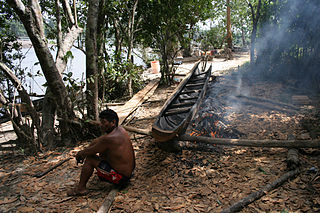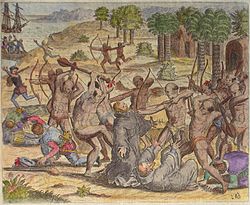The history of Trinidad and Tobago begins with the settlements of the islands by Indigenous First Peoples. Trinidad was visited by Christopher Columbus on his third voyage in 1498,, and claimed in the name of Spain. Trinidad was administered by Spanish hands until 1797, but it was largely settled by French colonists. Tobago changed hands between the British, French, Dutch, and Courlanders, but eventually ended up in British hands following the second Treaty of Paris (1814). In 1889, the two islands were incorporated into a single political entity. Trinidad and Tobago obtained its independence from the British Empire in 1962 and became a republic in 1976.

The Arawak are a group of indigenous peoples of northern South America and of the Caribbean. Specifically, the term "Arawak" has been applied at various times from the Lokono of South America to the Taíno, who lived in the Greater Antilles and northern Lesser Antilles in the Caribbean. All these groups spoke related Arawakan languages.

Amazonas State is one of the 23 states into which Venezuela is divided. It covers nearly a fifth of the area of Venezuela, but has less than 1% of Venezuela's population.

The Cariban languages are a family of languages indigenous to north-eastern South America. They are widespread across northernmost South America, from the mouth of the Amazon River to the Colombian Andes, and they are also spoken in small pockets of central Brazil. The languages of the Cariban family are relatively closely related. There are about three dozen, but most are spoken only by a few hundred people. Macushi is the only language among them with numerous speakers, estimated at 30,000. The Cariban family is well known among linguists partly because one language in the family—Hixkaryana—has a default word order of object–verb–subject. Prior to their discovery of this, linguists believed that this order did not exist in any spoken natural language.

The classification of the Indigenous peoples of the Americas is based upon cultural regions, geography, and linguistics. Anthropologists have named various cultural regions, with fluid boundaries, that are generally agreed upon with some variation. These cultural regions are broadly based upon the locations of the Indigenous peoples of the Americas from early European and African contact beginning in the late 15th century. When Indigenous peoples have been forcibly removed by nation-states, they retain their original geographic classification. Some groups span multiple cultural regions.

Ceramics of Indigenous peoples of the Americas is an art form with at least a 7500-year history in the Americas. Pottery is fired ceramics with clay as a component. Ceramics are used for utilitarian cooking vessels, serving and storage vessels, pipes, funerary urns, censers, musical instruments, ceremonial items, masks, toys, sculptures, and a myriad of other art forms.
At the time of first contact between Europe and the Americas, the indigenous peoples of the Caribbean included the Taíno of the northern Lesser Antilles, most of the Greater Antilles and the Bahamas, the Kalinago of the Lesser Antilles, the Ciguayo and Macorix of parts of Hispaniola, and the Guanahatabey of western Cuba. The Kalinago have maintained an identity as an indigenous people, with a reserved territory in Dominica.

The Kalina, also known as the Caribs or mainland Caribs and by several other names, are an Indigenous people native to the northern coastal areas of South America. Today, the Kalina live largely in villages on the rivers and coasts of Venezuela, Guyana, Suriname, French Guiana, and Brazil. They speak a Cariban language known as Carib. They may be related to the Island Caribs of the Caribbean, though their languages are unrelated.
The Saladoid culture is a pre-Columbian indigenous culture of territory in present-day Venezuela and the Caribbean that flourished from 500 BCE to 545 CE. The Saladoid were an Arawak people. Concentrated along the lowlands of the Orinoco River, the people migrated by sea to the Lesser Antilles, and then to Puerto Rico.
The Ortoiroid people were the second wave of human settlers of the Caribbean who began their migration into the Antilles around 2000 BCE. They were preceded by the Casimiroid peoples. They are believed to have originated in the Orinoco valley in South America, migrating to the Antilles from Trinidad and Tobago to Puerto Rico. The name "Ortoiroid" comes from Ortoire, a shell midden site in southeast Trinidad, they have also been called Banwaroid after another archaeological site in Trinidad

The languages of Venezuela refers to the official languages and various dialects spoken in established communities within the country. In Venezuela, Castellan is the official language and is the mother tongue of the majority of Venezuelans. Although there is an established official language, there are countless languages of indigenous villages spoken throughout Venezuela, and various regions also have languages of their own.

The Ye'kuana, also called Ye'kwana, Ye'Kuana, Yekuana, Yequana, Yecuana, Dekuana, Maquiritare, Makiritare, So'to or Maiongong, are a Cariban-speaking tropical rain-forest tribe who live in the Caura River and Orinoco River regions of Venezuela in Bolivar State and Amazonas State. In Brazil, they inhabit the northeast of Roraima State. In Venezuela, the Ye'kuana live alongside their former enemies, the Sanumá.

The Pemon language, is an indigenous language of the Cariban family spoken by some 30,000 Pemon people, in Venezuela's Southeast, particularly in the Canaima National Park, in the Roraima State of Brazil and in Guyana.

Timoto–Cuica people were an indigenous people of the Americas composed primarily of two large tribes, the Timote and the Cuica, that inhabited in the Andes region of Western Venezuela. They were closely related to the Muisca people of the Colombian Andes, who spoke Muysccubun, a version of Chibcha. The Timoto-Cuicas were not only composed of the Timote and the Cuica groups, but also of smaller tribes including the Mucuchíes, the Miguríes, the Tabayes and the Mucuñuques.
Caquetío is an extinct Arawakan language family. The language was spoken along the shores of Lake Maracaibo, in the coastal areas of the Venezuelan state of Falcón, and on the Dutch islands of Aruba, Bonaire and Curaçao.

The Pre-Columbian period in Venezuela refers to the period before the Spanish colonization of the Americas in the 16th century, known as the Pre-Columbian era. It covers the history of what are now known as the indigenous peoples of Venezuela.

Indigenous peoples in Guyana, Native Guyanese or Amerindian Guyanese are Guyanese people who are of indigenous ancestry. They comprise approximately 9.16% of Guyana's population. Amerindians are credited with the invention of the canoe, as well as Cassava-based dishes and Guyanese pepperpot, the national dish of Guyana. Amerindian languages have also been incorporated in the lexicon of Guyanese Creole.

The pre-Columbian cultures of Colombia refers to the ancient cultures and civilizations that inhabited Colombia before the Spanish Conquest in the 16th century.

















